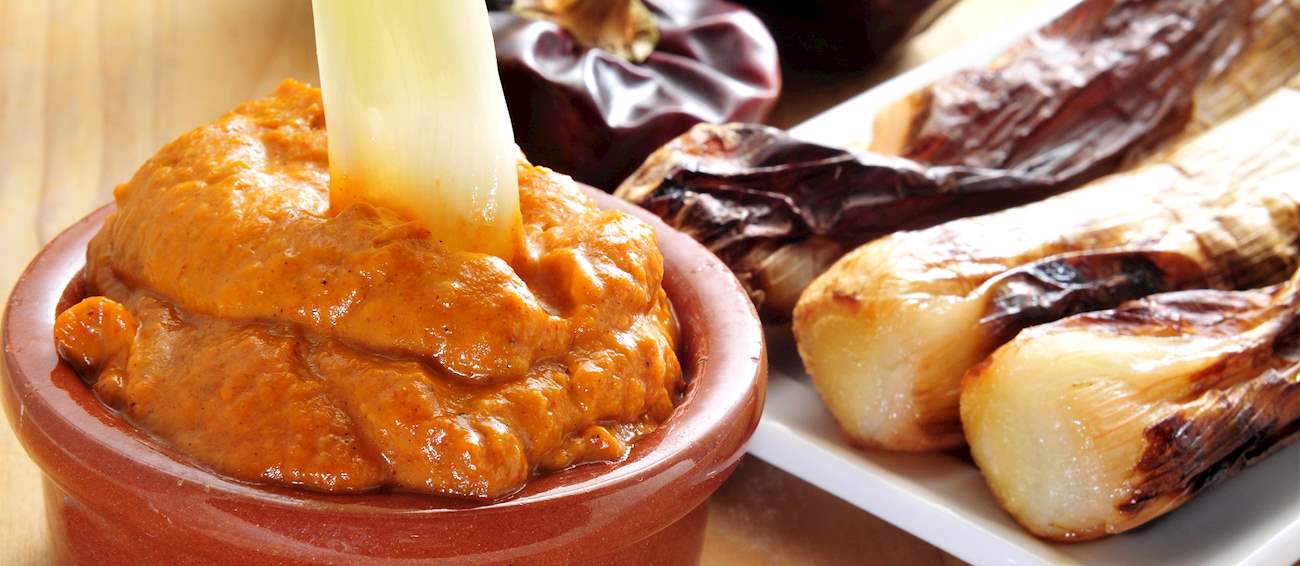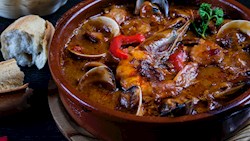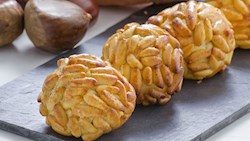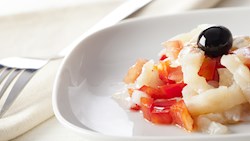Crema Catalana is a popular Spanish dessert made by baking a custard consisting of milk, cornstarch, and eggs in an oven. After baking and cooling, the dessert is sprinkled with sugar and broiled or burnt with a torch to create a crispy, burnt caramel top layer.
Sometimes, crema Catalana may be flavored with cinnamon, lemon, or orange zest. The dessert is also known as Crema de Sant Josep, since it is traditionally prepared on March 19, celebrating the saint. It is also the oldest European custard dessert, dating back to the 14th century.
MOST ICONIC Crema Catalana
View moreMAIN INGREDIENTS
Romesco is a savory Spanish sauce consisting of red peppers, tomatoes, onions, and a variety of roasted or raw nuts such as pine nuts, hazelnuts, and almonds. The sauce is extremely versatile, so it can be served with fish, seafood, salads, vegetables, and meat dishes, although it can also be used in stews, giving them a savory richness.
Romesco is also traditionally consumed as a dipping sauce for grilled spring onions, which is another Catalan delicacy.
Serve with
The classic Catalan invention known as pa amb tomàquet consists of toasted slices of bread that are sprinkled with salt, rubbed with tomatoes, and drizzled with olive oil (purists insist on rubbing both sides of the bread with tomatoes).
The first recipe for this dish dates back to 1884, when stale bread was rubbed with tomatoes in order to soften it. It is recommended to use a rustic sourdough called pa de pagès and tomatoes on the vine, since they have a unique, intense flavor.
The dish is usually consumed for breakfast or served before a big meal, as a tapa, or for merienda.
OTHER VARIATIONS OF Tapas
MOST ICONIC Pa amb tomàquet
View moreFricandó amb moixernons is a classic Catalan dish of casseroled veal. There are as many variations on this dish as there are cooks. Dating back to the beginning of the 18th century, the dish is prepared with small, flattened slices of veal (rump, shank, round, flank), onions, carrots, tomatoes, almonds, garlic, flour, white wine, carquinyoli biscuits, and moixernons (fairy ring mushrooms).
Optional ingredients include bacon and a bit of dark chocolate. The meat is covered with the sauce and a picada consisting of parsley, chopped garlic, and carquinyoli biscuits. Fricandó amb moixernons is usually left to stand for a few hours or even a few days before serving so that the flavors become even better.
In its basic form, this traditional Catalan dessert is a simple combination of honey and mató (also known as brossat or brull)—a subtly sweet fresh cheese that is made from goat, sheep, or cow milk. The dish is assembled by placing a piece of mató and then generously drizzling it with honey.
A common homemade dessert as well as a regular restaurant dish, mel i mató is easily modified with the addition of nuts, jams, and dry or fresh fruit.
MAIN INGREDIENTS
Arròs negre is a Spanish dish originating from Valencia and Catalonia, and it is the most popular in Castellon and Tarragona. It is made with white rice, squid or cuttlefish, and squid ink, which gives the dish its characteristical black color.
The dish is often enriched with the addition of garlic, onions, fish stock, cubanelle peppers, olive oil, and sweet paprika, and many cooks like to add other types of seafood into the paella pan, such as shrimp and crab.
OTHER VARIATIONS OF Paella
MAIN INGREDIENTS
Escalivada is one of the most famous dishes from the Catalonia region of Spain, but it is also one of the simplest. The main ingredients include eggplants, bell peppers, and sometimes onions and tomatoes, typically grilled whole over hot embers.
The vegetables are then peeled, seeded, seasoned, and served as appetizers or side dishes, accompanying numerous roasted or grilled meat dishes and complementing each other. The name of the dish is derived from the word escalivar, meaning to roast over embers, to grill, or to roast in ashes.
It is believed that the first escalivada was prepared by farmers from the Pyrenees mountains, who would prepare the meal while the cattle was out on the pastures.
MOST ICONIC Escalivada
View moreMAIN INGREDIENTS
Escudella i carn d'olla is a popular, traditional Catalan soup filled with pasta, meat such as chicken or lamb, prosciutto pieces, ground pork, and botiffara sausage, with the addition of vegetables such as carrots, potatoes, and Swiss chard.
The soup is traditionally flavored with garlic, parsley, thyme, saffron, salt, and pepper. It is often made during the colder months or around Christmas, as its bold, rustic flavors are known to warm up anyone who consumes it. Escudella is consumed in two stages – first comes the broth with pasta, then the meat and vegetables.
MOST ICONIC Escudella i carn d'olla
View moreBotifarra is a Catalan specialty, a white sausage made almost in the same way as the morcilla blood sausage, but without blood. There is also a blood sausage variety of the sausage, called butifarra negra Catalana. The sausage is based on ancient Roman recipes and consists of pork meat and numerous spices and seasoning, as well as additional ingredients that may vary.
Some varieties of botifarra are made with unusual ingredients such as truffles, eggs, boiled rice, and tripe in the mixture. Although botifarra is usually not cooked, it can be boiled when prepared in the dish known as escudella i carn d'olla, a traditional Catalan dish with boiled vegetables, meat, and beans.
TasteAtlas food rankings are based on the ratings of the TasteAtlas audience, with a series of mechanisms that recognize real users and that ignore bot, nationalist or local patriotic ratings, and give additional value to the ratings of users that the system recognizes as knowledgeable. For the “Top 56 Catalan Foods” list until February 16, 2025, 1,839 ratings were recorded, of which 1,438 were recognized by the system as legitimate. TasteAtlas Rankings should not be seen as the final global conclusion about food. Their purpose is to promote excellent local foods, instill pride in traditional dishes, and arouse curiosity about dishes you haven’t tried.
















































